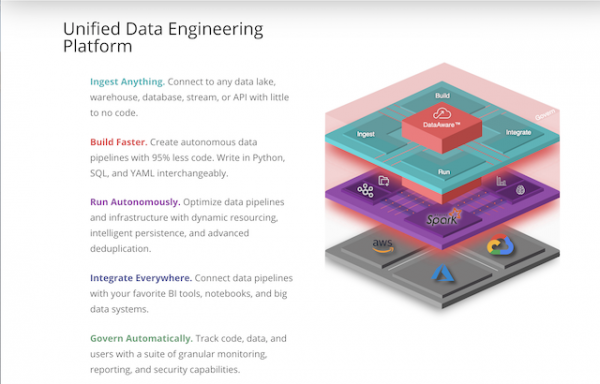Ascend has built a unified data engineering platform for building and running autonomous data pipelines. Ascend reduces data management complexity and productizes data engineering with its data flow automation system.

Ascend utilizes AI and a high level of automation to make its systems smarter and its products better, enabling data access to business without having to have a dedicated data engineering team to shuffle, fix and manage data all the time.
Ascend’s dataflow automation system can adapt and understand what the user is trying to accomplish and generate autonomous data pipelines. The system has more context than workflow automation systems. For example, Ascend understands the definition files, applies those findings to the data, and can dynamically adapt to changes in the environment, code, or data – all with 95% less code.
Ascend’s AI uses heuristics and statistics and is pushing data rather than pooling. It is a pipeline engine, not a storage engine or processing engine.
Ascend’s DataAware intelligence system is designed to ensure that the same code is never rerun the same data – reducing repetitive workloads and accelerating the data pipeline.
Let’s compare this to a traditional workflow automation system.
Traditional Workflow Automation Systems Vs. Dataflow Automation Systems
One of the benefits of using a traditional workflow automation system is the maturity of the technological developments. Systems like these have been around for a long time and are a well-understood approach to data management.
Workflow automation systems are also able to automate pretty much any task thrown at them programmatically. They do not require any representation of the semantics, inputs, or outputs of tasks, according to Ascend. This means that there is often no limitation on the programming language, model, or tool used to implement tasks.
Workflow automation systems have simplicity of dependency semantics; they are simple and easy to write. Some systems can display dependency graphs as images to ease understanding of task relationships.
With the evolution of IT and the surge in data growth, do businesses want to use something because it’s been around for a long time and is easy?
What Does a Dataflow Automation System do Better?
Dataflow systems are designed to reflect entire data sets as an organized set of objects. These systems will manage relationships between objects, inside individual tasks, and across datasets. Users only need to consider the overall dataset when designing and managing specs and let the dataflow system manage the lower-level details. This allows users to design and maintain far larger, more complex systems.
Dataflow systems cost less in terms of supportability costs than traditional workflow automation systems. Why? Because with dataflow systems, fixes are automated. The system can monitor and fix most task failures without the data engineering team having to lift a finger. This reduces cost and means it is simpler to manage than workflow systems, where failure will happen at scale.
Failure in a workflow system is not an automated or easy fix. Diagnosis is manual; users have to watch and wait to observe the failure while tasks run. According to Ascend, with workflow systems, the hard-coded assumptions made – based on data at the point-of-initial development – will change over time. As this change happens, more failures happen, errors grow, and the cost to fix surges.
According to Ascend, with an AI-driven understanding of transformations, dataflow automation systems can algorithmically rewrite graphs to produce the same results faster or cheaper than workflow automation systems.
Other benefits include sets of rich, extensible metadata representing high-level system specifications and low-level storage objects and tasks. The richness of this metadata model allows these systems to do thorough correctness and consistency checks.
Conclusion
Managing data and reducing complexity is what matters in our technical world. If there is a system out there that can reduce complexity, code, breaks, and prevent those mind-numbing hours waiting for an error to happen, it’s worth it.
Ascend promises this and more.
To learn more about its system, head on over to Ascend.IO.




